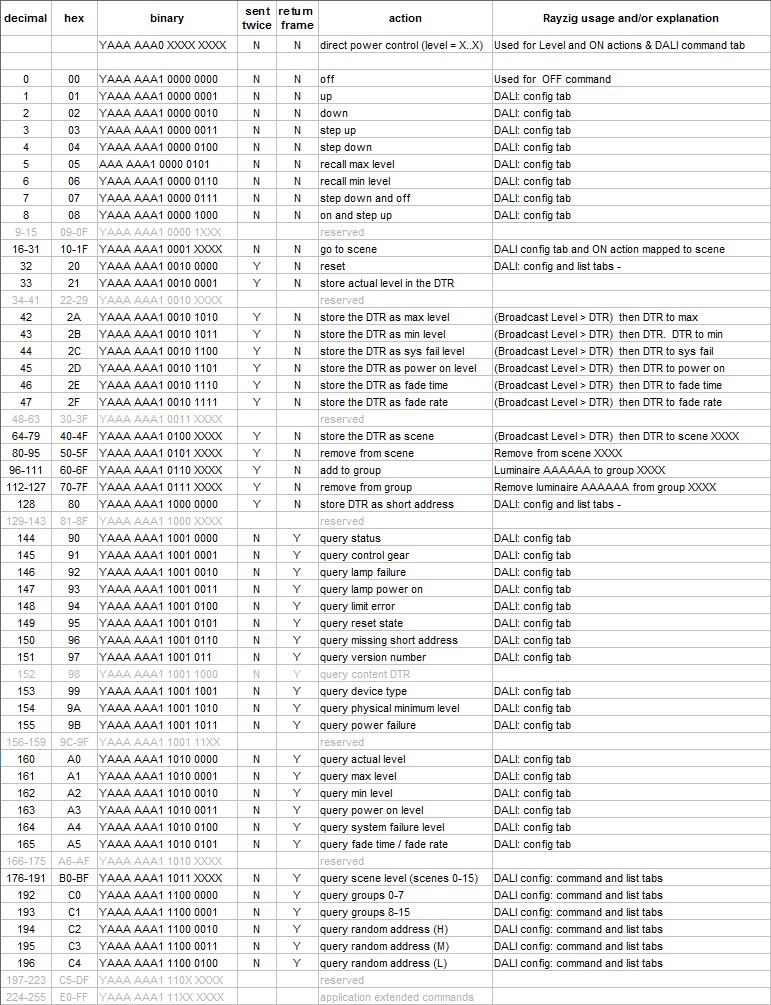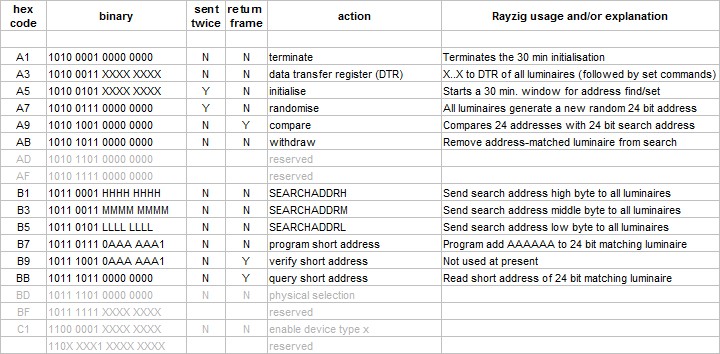Author: Jovan Stosic
Interface DALI and Arduino. Real surrealism / Sudo Null IT News
https://sudonull.com/post/16884-Interface-DALI-and-Arduino-Real-surrealism
Cheap logic analyzer SPI i2c UART – YouTube
Network Analyzer LA1002 Mini Portable USB 5MHz 24M 8 Channel Logic Analyzer Device Set with Cables Network Analyzing Tool| | – AliExpress
MHz 24M 8 C
DALI commands
11.2 DALI commands
- DALI commands are transmitted on the DALI bus at 1200 bit/sec using Manchester coding.
In Manchester coding, the bit state is defined by a transition at the centre of the bit window (ie: NOT by the actual level)
ie: positive going transition = ‘1’, negative going transition = ‘0’.
This needs a signal switching rate of twice the actual bit transmission rate. - DALI commands are transmitted as frames of 16 bits (+ start and stop pulses)
- Some commands have to be repeated to be effective (within 100mS)
This is done automatically within the Rayzig DALI output module. - Some commands have 8 bit return frames.
Raymon reports on the header panel: Return frame byte = nn
OR if no response: absent return frame. - Some commands have no return frame.
Raymon reports: frame with no response.
Addressing
DALI slave addressing is by one of:
- Individual luminaires addressing using their short addresses (0–63)
- Group addressing which accesses one of 16 groups (0-15)
(Each luminaire can be assigned to one of more groups) - Broadcast which addresses all slave units on the DALI bus.
Scenes
Each luminaire can participate in one of more of 16 available DALI scenes.
For each scene, the luminaire stores a level (0-254) for that scene or 255 if not participating.
A GOTO SCENE NN command causes each participating luminaire to switch to its level for scene NN.
Addressing in the 16 bit transmitted frame
A brief summary of DALI addressing is given in the table below.
The following coding is used to illustrate the bit usage:
S: selector bit: S = ‘0’ direct power level in lower byte
S = ‘1’ command in lower byte
Y: short or group address: Y = ‘0’ short address
Y = ‘1’ group address or broadcast
A: significant address bit
C: significant command bit
|
Type of addressing |
address byte |
|
Short addresses (0-63) |
0AAAAAAS |
|
Group addresses (0-15) |
100AAAAS |
|
Broadcast |
1111111S |
|
Special command |
101CCCC1 |
|
Special command |
110CCCC1 |
The table below lists the DALI commands currently used by Rayzig.

List of DALI commands used by Rayzig (part 1)
Operational control in Rayzig uses only DIRECT POWER CONTROL and OFF with individual and group addressing
plus GOTO SCENE with broadcast addressing.
The other commands are used in configuration. (Greyed-out commands are unused)

DALI commands tab
11.17 DALI module configuration – command tab
The DALI configuration window opens on the Luminaire list tab page.
Click the Commands tab at the top to switch to the commands tab page.
The commands tab page is in several sections as shown below.
Each is section is discussed separately.

Double click for full sized image
Level setting
There are three level/value setting spin-edit controls on the page.
A slider control allows rapid setting of these three controls.
Note that these level controls are DALI levels (0-254). The % value corresponds to Rayzig levels (0-100).

The  sends the specified level to luminaires, according to the current
sends the specified level to luminaires, according to the current
addressing setting (ie: one luminaire or a luminaire group or a broadcast to all luminaires).
Address, scene and group controls
These controls all have drop down lists which allow rapid value setting by selection.
Command information
The following data is displayed for some commands. See: DALI commands – DALI addressing
|
The last transmitted 16 bit frame |
|
|
The address byte |
|
General commands and addressing
There are eight buttons as shown below.
These can act on luminaires addressed as luminaires or groups or by broadcast to all luminaires.
In the example below, luminaire addressing is selected for luminaire 2.
Note that operational control by Rayzig only uses the Off command for an OFF action.
Rayzig ON and level changes actions use direct power level setting.
The addressing settings are used by the eight buttons, by Goto scene and for Direct power level setting.

Setting luminaire control values
This panel allows the setting of six luminaire control parameters as shown on the buttons.
The setting process of each button makes use of two DALI commands:
- Extended command A3 (DATA TRANSFER REGISTER) is broadcast to put
the new value into the Data Transfer Register (DTR) of all luminaires. - A button-specific command, eg: 42 ( STORE DTR AS MAX LEVEL) is then sent to luminaire 2
to make it use its newly set DTR value as a new maximum level.

The button: Send value to all DTRs sends extended command A3,
ie: just the first of the two commands above.
Note than some luminaire parameters (eg: minimum level) may have fixed internal lower limits.
Reading luminaire values
These 18 buttons use the same luminaire address box as the setting buttons.
They send a single command, eg: 161 = QUERY_MAX_LEVEL
Note that Query fade time/rate is a single DALI command which returns an 8 bit byte.
The lower 4 bits are fade rate and the upper 4 bits are fade time.

DALI group management
This panel duplicates the functions of the group editor window accessed from the luminaire listing.
Current group membership is displayed automatically on changing the luminaire selection.
If a luminaire list has been built on the listing tab page, then group membership information
is immediately available. If not, then it is read from the selected luminaire.
Changes to group membership automatically update the group membership sub-panel.
The luminaire list is automatically updated with the revised group membership on returning
to the listing tab page.

DALI scene management
This panel duplicates the functions of the scene editor window accessed from the luminaire listing.
Current scene membership and levels are displayed automatically on changing the luminaire selection.
If a luminaire list has been built on the listing tab page, and scene data added, then scene information
is immediately available. If not, then Raymon reads the 16 scene levels of the selected luminaire.
Changes to scene settings update the scene membership sub-panel and scene level display.
The luminaire list is automatically updated with the revised scene information on returning
to the listing tab page.

Manual commissioning – binary searches and address assignment
The controls for address assignment duplicate the functions of the same controls
on the listing tab page. The detailed description is therefore not repeated here.
Please see: DALI addressing new luminaires DALI new + existing luminaires
DALI address setting explained
The Send 24 bit search address and compare button performs one cycle of the binary search process.
It allows you to perform a binary search by manually changing the 24 bit search address after each cycle.
The Luminaires sub-panel has the following buttons:
- Reset Luminaire which clears all data except the short address.
- Query 24 bit address which reads the 24 bit random address of a specified luminaire.
- Query luminaire address using 24 bit address. This button returns the short address
of a luminaire that has been found by a binary search.
ie: The luminaire with random address = the search address currently in its search buffer
(This is the search address broadcast by the most recent Search and Compare action.
Such action is performed by the Search and compare button or each stage of a binary search.) - The Use invalid switch is explained in: DALI search – Use invalid

ownCloud Client Portable
Source: naderi/owncloud-client-portable: ownCloud Client Portable
Pale Blue Dot: A Vision of the Human Future in Space: Carl Sagan: 8580001110042: Amazon.com: Books
https://www.amazon.com/Pale-Blue-Dot-Vision-Future/dp/0345376595
Skunk Works: A Personal Memoir of My Years at Lockheed: Ben R. Rich: 9780316743006: Amazon.com: Books
https://www.amazon.com/Skunk-Works-Personal-Memoir-Lockheed/dp/0316743003
Astronomik MC-Clear for Canon EOS 1000D, 40D-250D, 450D-800D, 7D, M
https://www.astronomik.com/en/astronomik-mc-klarglas-for-canon-eos-450d-500d-550d-600d-1000d.html
Raspberry Pi and Plex: create your own media server
https://www.ionos.com/digitalguide/server/configuration/raspberry-pi-plex/
Cantaloupe Image Server
https://cantaloupe-project.github.io/

